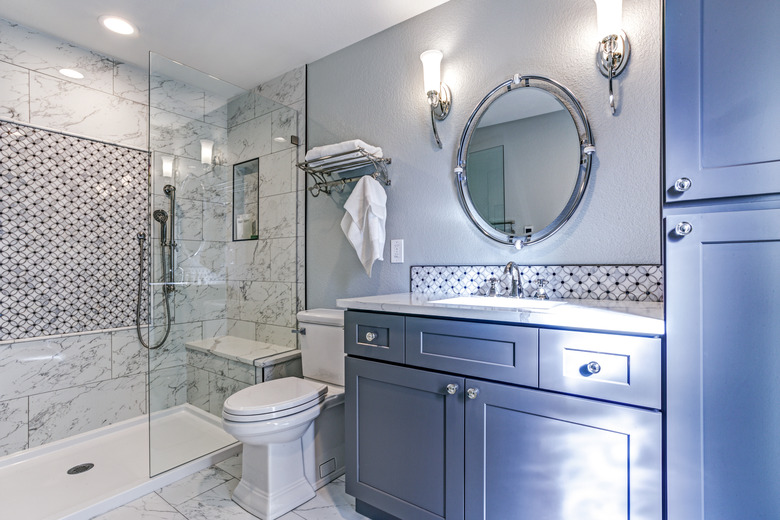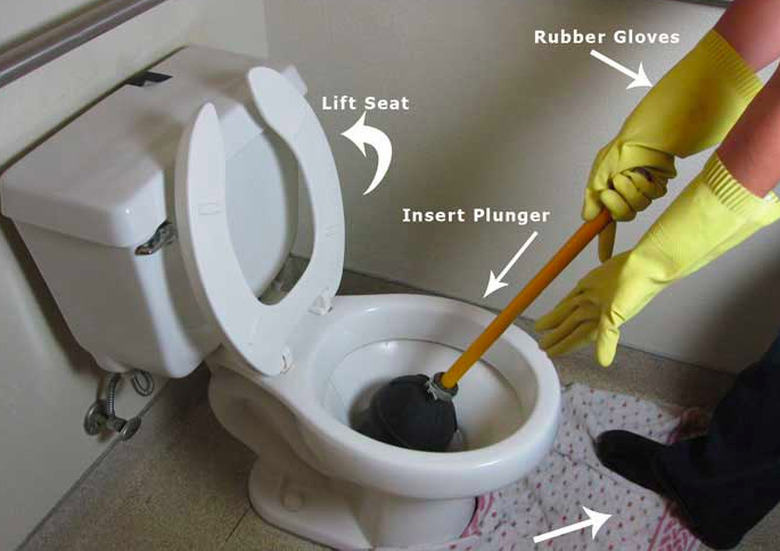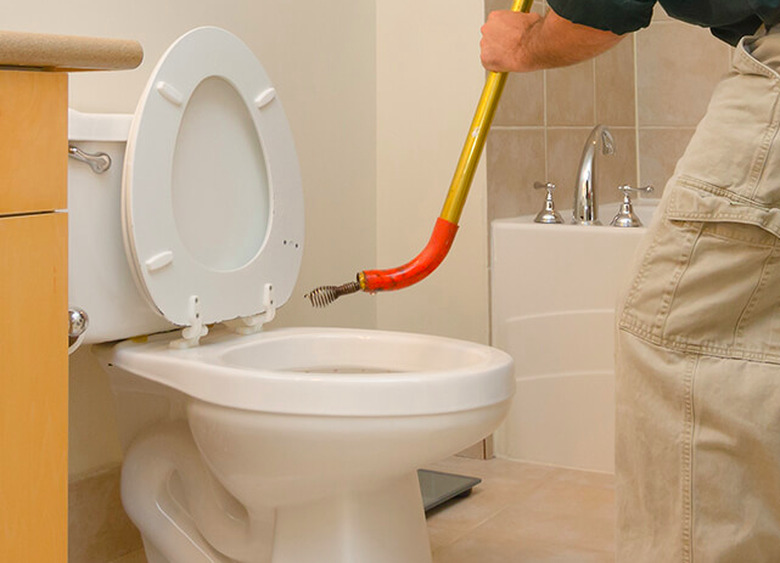Can You Use Drano In A Toilet
We may receive a commission on purchases made from links.
Got a clogged toilet? Navigate to Drano's website, and the advice you'll get will be to use a plunger or auger to clear the clog or call a plumber. Not even the manufacturer, SC Johnson, recommends pouring Drano down the toilet. There are several good reasons for this, not the least of which is that it probably won't work.
Unlike sink clogs, which are usually caused by soap, hair and grease, a toilet clog is usually quite hard. If the clog is hard enough to fill a 3- or 4-inch-diameter waste pipe, Drano probably won't eat through the clog. Apart from that, many toilet clogs happen for reasons for which Drano is ineffective, such as poor venting, tree roots in the sewer system or a backed up septic tank. In any of these situations, adding Drano will just make things worse.
Drano does make a product that can help reduce the chances of a clog. It's an enzyme-based liquid that slowly eats the sediment that collects in pipes before it can coalesce into a clog. However, this isn't Drano's signature product, the one that made the name Drano synonymous with drain cleaners. The classic drain-cleaning Drano is best reserved for sink, tub and shower drains. Like most liquid drain cleaners, it can damage pipes and should be used only in emergencies. And don't put it into your toilet at all.
How Drano Works
How Drano Works
The active ingredients in most Drano products are sodium hydroxide (lye), and sodium hypochlorite (bleach). Sodium hydroxide is caustic, and it basically eats the greases, soap scum and other gunk that form clogs, generating a large amount of heat in the process. As an oxidizing agent, bleach works by converting the clogs into other types of chemicals that can wash away. Think of metal turning to rust and you'll get an idea of the power of oxidation.
Obviously, both of these chemicals are hard on gunk, but they are also hard on pipes—especially metal ones. PVC pipes can withstand the corroding effects of drain cleaners better than metal pipes, but they aren't immune to heat. The harmful effects are compounded by the fact that the drain cleaner usually remains in the pipes for an extended period—often overnight—until the clog is busted.
Drano Can Hurt You and Your Toilet
Drano Can Hurt You and Your Toilet
Consider the following scenario: You put Drano into your toilet to bust a clog, you wait overnight and wake up in the morning to find that the chemical drain cleaner hasn't worked. Now instead of just a clogged toilet, you have a clogged toilet filled with highly caustic Drano. If you try to plunge the clog or break it up with an auger and splash water on yourself, you may very well get a skin burn. This is a very real hazard. Skin burns from sodium hydroxide—sometimes known as caustic soda—can be serious and may require medical attention.
If that isn't enough to make you think twice about filling your toilet with Drano, think about what it can do to the toilet. If the clog is in the toilet P-trap and not in the pipe, the chemicals will fill part of the trap and remain there, generating heat until the clog moves. If the heat generated by sodium hydroxide is intense enough to give you a burn, it can also actually crack the porcelain. This isn't likely, but you don't want to be one of the rare people who discovers the hard way that it actually does happen occasionally.
Avoid All Chemical Drain Cleaners in Toilets
Avoid All Chemical Drain Cleaners in Toilets
Although Drano is one of the most famous, there are plenty of other chemical drain cleaners that contain virtually the same chemicals, or other chemicals that are equally problematic for toilets. There is no chemical drain cleaner that should be used to remove clogs in a toilet.
How to Deal with Clogs Safely and Effectively
How to Deal with Clogs Safely and Effectively
Every bathroom should have a bell-shaped toilet plunger. When the toilet gets clogged, that is usually the only tool you need, provided you use the proper technique. Be sure to tip the plunger head at an angle to allow it to fill with water, then fit the flange securely around the toilet inlet and pump repeatedly with as much strength as you can muster. For stubborn clogs deep in the waste pipe, it often helps to tape over the tub, shower and sink drain in the bathroom where the toilet is located. This seals those openings and focuses your pumping power on the toilet clog, preventing the force from dissipating uselessly through those open drains.
A toilet auger, sometimes called a closet auger or closet snake, is designed to fit into the toilet opening and to extend through the curves of the P-trap to the drain opening in the floor below the toilet. It's the tool to use for clearing material lodged in the toilet itself when you aren't having any luck with a plunger. A toilet auger isn't long enough to reach into the waste pipe, though, so if you have it fully extended, and it isn't clearing the clog, you have three options:
- The first option is to remove the toilet and try clearing the clog by inserting a drain auger directly into the drain opening.
- Or, you can also locate a cleanout fitting on the sewer and insert a drain auger through there. If you choose either of these options, you'll have more luck with a sewer auger than you will with a toilet auger. The sewer auger is longer and better designed for clearing pipes.
- The third option is to call a plumber, which is what you should do if you're experiencing chronic blockages or blockages in more than one fixture at the same time. Plumbers have the tools needed to diagnose systemic problems deep in the waste system that could be caused by tree roots or septic backups.


